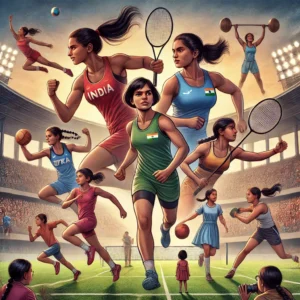Kushti, also known as Pehlwani, is a form of traditional Indian wrestling that has deep roots in the country’s cultural heritage. Practiced for centuries, Kushti is more than just a sport; it is a way of life that embodies discipline, strength, and spiritual balance. Traditionally, it is practiced in mud pits called akhara, where wrestlers, known as pehlwans, train under the guidance of a guru or mentor. Kushti has played a vital role in the cultural and social fabric of rural India, with matches often held during local festivals and religious gatherings, bringing communities together. Despite facing challenges in the modern era, Kushti remains an enduring symbol of India’s rich sporting tradition. As the global sports industry evolves, efforts are being made to preserve and revive Kushti, ensuring it continues to hold a place in contemporary Indian sports culture.
The Origins and Cultural Significance of Kushti
Kushti has its origins in ancient India, where it was practiced as both a form of combat training and a spiritual discipline. The roots of Kushti can be traced back over 3,000 years, with references found in ancient texts like the Mahabharata and Ramayana, where wrestling matches were held to showcase strength and valor. During the Maurya and Gupta periods, wrestling became an organized sport, with emperors sponsoring matches and supporting the training of pehlwans in royal akhara. This period marked the beginning of Kushti’s rise as a respected practice, valued for its ability to cultivate physical strength, mental focus, and moral discipline.
Kushti’s cultural significance in India extends beyond its role as a sport. It is closely linked with traditional Indian philosophy and spirituality, with many practitioners viewing their training as a form of self-discipline and devotion. The guru-shishya (teacher-student) tradition in akhara embodies the spiritual bond between mentor and disciple, emphasizing respect, humility, and dedication. Wrestlers adhere to a strict regimen that includes not only physical training but also dietary restrictions and lifestyle choices, aimed at achieving both physical prowess and mental purity.
In rural India, Kushti has been an integral part of local festivals and village gatherings. Wrestling competitions are often held during religious events, where the entire community comes together to celebrate and cheer for their local pehlwans. These events have served as a platform for social interaction, fostering a sense of pride and unity among villagers. Winners of such matches are regarded with high respect, symbolizing ideals of strength and honor within the community.
Kushti also played a role in the Indian independence movement, where it was seen as a symbol of resistance against colonial rule. During the British Raj, traditional Indian practices, including Kushti, were discouraged in favor of Western sports like cricket and football. However, Kushti persisted, with Indian pehlwans continuing to train and compete, preserving their heritage and cultural identity. This resilience helped maintain the sport’s cultural relevance even as India transitioned into modernity.
Today, Kushti continues to be a testament to India’s rich history, reflecting values of resilience, discipline, and cultural pride. Its practice in akhara across the country remains a link to the past, providing a window into a time when physical training was intertwined with spiritual growth. Despite the pressures of modernization and competition from other sports, the cultural roots of Kushti remain strong, making it an enduring part of India’s sporting identity.
The Art of Kushti: Techniques and Training Methods
Kushti is a highly technical sport that requires mastery of various grappling techniques, holds, and throws. Training in Kushti involves a unique blend of strength building, agility, and strategic thinking, all of which are essential for success in the wrestling pit.
Key Techniques Practiced in Kushti
In Kushti, pehlwans learn a range of techniques designed to pin their opponents to the ground. Common moves include the dhobi pachad, where a wrestler lifts their opponent off the ground and slams them down, and the kashera, a strategic hold used to control the opponent’s movements. Kushti techniques emphasize the use of leverage and body weight, allowing even lighter wrestlers to defeat heavier opponents through skill and precision.
Traditional Training in Akharas
Training in Kushti takes place in akhara, traditional wrestling gyms where pehlwans practice on mud floors instead of modern mats. The mud is treated with natural ingredients like ghee and turmeric, believed to have healing properties that protect against injuries. Wrestlers perform rigorous daily routines, starting early in the morning with exercises like dand (push-ups) and bethak (squats) to build core strength. Wrestling drills, mock matches, and sparring sessions follow, allowing wrestlers to refine their techniques and build endurance.
Role of Diet and Discipline in Kushti Training
A strict diet is an essential part of a pehlwan’s regimen, focused on building muscle mass and maintaining peak physical condition. The traditional diet includes khoya (milk solids), almonds, ghee, and other high-protein foods. Alcohol, smoking, and processed foods are strictly avoided, as discipline in eating is considered just as important as physical training. The dietary discipline and simple lifestyle followed by pehlwans reflect the holistic approach of Kushti, which seeks to develop both body and mind.
Through these training methods, Kushti preserves a rich tradition of physical excellence and discipline, offering a distinctive approach to fitness that contrasts with modern gym-based training.
Kushti’s Challenges in the Modern Era
Despite its rich history, Kushti faces several challenges in maintaining its relevance in modern India, where new sports and entertainment options compete for attention.
- Decline in Popularity Among Urban Youth: With the rise of urbanization, traditional practices like Kushti have struggled to attract young people in cities. Modern sports like football, cricket, and even martial arts like mixed martial arts (MMA) have gained popularity, drawing interest away from traditional wrestling. Urban youth often see Kushti as a sport tied to rural traditions, lacking the glamour and exposure that other sports receive.
- Competition from Other Combat Sports Like MMA and Professional Wrestling: The global popularity of combat sports such as MMA and professional wrestling has also posed a challenge for Kushti. Unlike Kushti, these sports offer opportunities for international competition and higher financial rewards, attracting aspiring athletes who seek broader recognition. MMA’s modern training facilities and global appeal have led many young wrestlers to transition to more commercially viable combat sports.
- Lack of Financial Support and Modern Facilities: While traditional akhara continue to train wrestlers using age-old methods, they often lack the financial support needed to improve their facilities. This has made it difficult for akhara to compete with modern sports academies that offer advanced training methods and equipment. Many talented wrestlers are forced to abandon Kushti due to a lack of sponsorships, making it difficult for the sport to attract and retain talent.
- The Struggle to Preserve Traditional Values in the Face of Commercialization: As sports in India become increasingly commercialized, Kushti faces the challenge of maintaining its traditional values while adapting to new market realities. While some efforts have been made to promote Kushti through televised tournaments and documentaries, there is a risk that the essence of the sport—its simplicity, discipline, and connection to spirituality—could be lost in the process. Balancing tradition with the need for modernization is a delicate task that many practitioners are grappling with.
These challenges threaten the survival of Kushti as a mainstream sport in India. However, the resilience of its practitioners and the efforts of those dedicated to preserving its legacy provide hope for its revival and continued relevance in Indian society.
Kushti’s Role in Contemporary Sports Culture
Despite the challenges, Kushti remains an important part of India’s sports culture, with several efforts being made to ensure its survival and growth.
- Revival Efforts Through National Tournaments
Various organizations have started to organize national and state-level Kushti tournaments to bring more visibility to the sport. These events provide a platform for pehlwans to showcase their skills and compete in a formal setting, helping to revive interest in the sport among both participants and spectators. - Media and Film’s Role in Popularizing Kushti
Movies like “Dangal” and “Sultan” have played a significant role in bringing Kushti back into the mainstream consciousness. By highlighting the struggles and triumphs of wrestlers, these films have inspired many young Indians to take up wrestling, contributing to a renewed interest in traditional forms of the sport. - Inclusion of Kushti in School and College Programs
Some schools and colleges have started including Kushti in their sports programs, recognizing its benefits for physical fitness and mental discipline. This has helped introduce the sport to a new generation, creating opportunities for young people to engage with the sport in a structured environment. - Integration of Modern Training Techniques with Traditional Practices
Some akhara are now blending traditional training methods with modern sports science, including strength and conditioning programs. This integration allows wrestlers to compete more effectively on both national and international stages, while still preserving the core elements of Kushti. - The Rise of Female Wrestlers in Traditional and Freestyle Wrestling
The increasing participation of women in Kushti has brought new energy to the sport. Female wrestlers have made significant strides in both traditional and freestyle wrestling, challenging stereotypes and gaining recognition for their achievements. This has not only helped promote gender equality in sports but has also attracted more attention to Kushti as a whole.
These developments show that, while Kushti may be evolving, it continues to play a meaningful role in India’s sports culture.
The Futureф of Kushti: Balancing Tradition and Modernity
The future of Kushti lies in striking a balance between preserving its traditional roots and adapting to the changing landscape of modern sports. To ensure its longevity, Kushti must continue to embrace modernization efforts without losing the essence that makes it unique.
Investing in infrastructure, such as improving akhara facilities and providing better financial support, can help attract new talent. At the same time, preserving the traditional training methods and values of respect, discipline, and simplicity is crucial for maintaining the sport’s cultural significance. Embracing digital platforms for promoting matches and sharing stories of pehlwans can also help Kushti reach a wider audience, connecting with a generation that is more familiar with technology.
Ultimately, the key to Kushti’s future is inclusivity and accessibility, ensuring that the sport is open to all, regardless of gender or socioeconomic background. By building on its rich heritage while embracing change, Kushti can remain an integral part of India’s sporting landscape, inspiring future generations to take pride in this ancient tradition.



